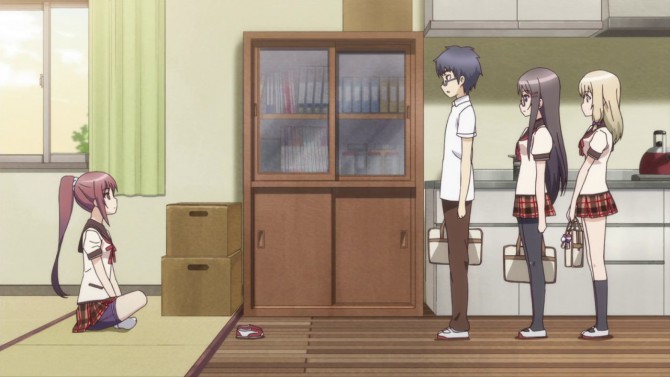July 19th, 2015 in Anime, General Reviews, Sunday Without God by The Droid

I usually do not like post-apocalyptic shows, as it always presents the fall and demise of society; however “Sunday Without God” certainly goes in a different direction than you surmise. But there is a big problem with the logic and physics of this dying world we find ourselves in.
It is the future. Fifteen years earlier, God abandoned the world, but initially, didn’t tell anyone. The world made two discoveries: no one was dying and no one was being born. God later came down to say that Heaven was overcrowded (What? Really? And God couldn’t do anything about it?) and that there would be no new admittances and that we were on our own. But it’s like “Death Becomes Her”, in that you have to take care of your body. You can still die, but you just kind of hang around as your body rots away.
In this village of no given name, we find 12-year-old Ai Astin (dead center). Her mother was a gravekeeper, but since she was the last person who could really die and did so, Ai has taken over the position. She tends over the 134 graves in the village, ready for the day when she has to use them. A stranger comes into the town and proceeds to kill everyone, as he looks for this mysterious Hana. His name is Hampnie Hambart (to her right). Since she has no reason to stay in the village and he has places to go, they set out on a journey to try and find Hana and even to help Ai in her quest to save the world God has abandoned. (more…)
Tags: Fantasy, Mystery
July 16th, 2015 in Anime, General Reviews, Tamako Market by The Droid

Ah, young love. Is there anything more beautiful than young love? Well, maybe an ice-cold bottle of a long-necked Teutonic brew on a painfully hot day, but that’s just me. And I haven’t had young love in a long time. I remember, in my youth, when I was young and a youth and….ahem! Back to the review of “Tamako Market”.
Tamako Kitashirakawa (second from left) is the eldest daughter of a family who runs a mochi shop in the Usagiyama Shopping District. One day, Tamako encounters a strange talking bird named Dera Mochimazzi (I assume you can find that one) who comes from a distant land, searching for a bride for his country’s prince. After becoming overweight from eating too much mochi (a bird who’s a pig?), Dera ends up becoming a freeloader in Tamako’s home. The series follows the everyday life of Tamako, her friends, family and neighbors, and this peculiar bird. (more…)
Tags: Comedy, Slice of Life
March 26th, 2015 in Amagi Brilliant Park, Anime, General Reviews by The Droid

As we know, theme and amusement parks can give you the time of your life. But what if the enjoyment you have actually saves another person’s life? Thus is the idea behind “Amagi Brilliant Park”.
Seiya Kanie is a good looking, perfectionist boy (that guy dead center) who is forced by the mysterious Isuzu Sento (the red coat to his left) to visit an amusement park named Amagi Brilliant Park, which is in serious difficulties and about to be closed forever. Forced is right. Seldom do you start a romantic comedy anime with having a blunderbuss shoved in your face and ‘asked’ to come along on a date. Are things really that tough in schools in getting a guy?
The park is actually staffed by refugees from a magical realm called Maple Land, and the park is a facility for harvesting magical energy from visitors while they’re having fun. As such, the park is the only way the refugees can maintain their existence in the human realm. Yup, those characters that look like they are in costumes are not costumes, but real magical creatures. Even the Elementarios (those fairies to the left and back three rows) are, well, real fairies as we imagine them to be.
(more…)
Tags: Comedy, Magic, Romance
March 22nd, 2015 in Anime, General Reviews, Tokyo Ghoul by The Droid

OK, I KNEW this was a horror series, but I was drawn to “Tokyo Ghoul”, as you get tired of the vampire – werewolf – zombie nexus and I wanted to try something new, although they do play fast and loose with the mythology (which begs the question: can a myth be factually incorrect?) So, let’s set the history of ghouls. A true ghoul eats the corpses of the human dead, thus hanging around graveyards and the like. They might be akin to a politician. However, some ghouls are not beyond helping people become dead, so they can dine. Talk about a moveable feast!
So, we are in Tokyo (which helps for a show named “Tokyo Ghoul”). Let us meet Ken Kaneki, that young male youth up there. Things are going well for him: he’s in college, he’s found a rockin’ place to hang out and he meets this fabulous girl, Rize Kamishiro, that far-right woman. Now, not only is she out of Kaneki’s league, it isn’t even the same sport, but he is intrigued, as she wants him over for dinner. Yup, she’s a ghoul and has her eyes (and teeth) set on Kaneki. As she is busily killing him at a construction site, a hoist of I-beams snaps free from its hook and comes crashing down upon them.
A doctor just happened to be travelling by, comes across these two really messed-up people and thinks “We have the technology. We can rebuild him.” Taken to the hospital in critical condition, he transplants from Rize those important organs that weren’t crushed under several tons of steel into Kaneki. He lives! The operation was a success. No, it wasn’t. After recovering, Kaneki discovers that the operation transformed him into a half-ghoul, and just like them, he must consume human flesh to survive. (more…)
Tags: Action, Drama, Horror, Mystery, Psychological, Seinen, Supernatural
March 19th, 2015 in Anime, General Reviews, When Supernatural Battles Became Commonplace by The Droid

This is another show that started off with a good idea and then did nothing with it. It suffered from the first problem, in what is the name of the crfapping show? The search has it come up as “When Supernatural Battles Became Commonplace” (“Inō-Batoru wa Nichijō-kei no Naka de”), but it is also known in Japan as “Inou Battle Within Everyday Life” and “Inou-Battle in the Usually Daze.”
We are in Senkō High School’s Literature Club, who is reading “Hunger Game” or “Divergent” or “Fifty Shades of Gray”. The story focuses on its five members (from right to left) who are: Tomoyo Kanzaki, Hatoko Kushikawa, Jurai Andō, Chifuyu Himeki and Sayumi Takanashi. They have all developed superpowers from a strange and bizarre incident. These superpowers (such as they are) have now become a part of their everyday lives, as they battle against others wielding similar powers.
The sixth person, Mirei Kudō, is not part of the club, but the Student Council president, who also has obtained these powers. It’s just that the powers seem a bit limited. Slow down time or manipulate the basic elements or create matter or space. Then, once they figure out how to use these powers, they…………do nothing with them. They have a hard time understanding these powers anyway, but what do you do with them? There was an old “Saturday Night Live” sketch, “The Interesting Four”, superheroes with marginal powers, like Weather Woman, who can raise or lower the temperature in a room by 17 degrees. These folks are kind of like that. (more…)
Tags: Comedy, Romance, School, Slice of Life, Supernatural
March 15th, 2015 in Anime, Chaika-Coffin Princess: Avenging Battle, General Reviews by The Droid

Now, when “Chaika – The Coffin Princess” came to its conclusion, I knew a second season was in the offing, as the main plot wasn’t resolved. Well, the second season “Chaika – The Coffin Princess; Avenging Battle” does just that, but this is the third series I have encountered this year with a 10-episode second season. Oh, and a revelation uncovered from the first season is completely buried under for this run.
Well, our heroes (left to right) Toru Acura, Chaika Trabant and Akari Acura are still hunting for the remains of the Emperor Gaz, who ruled the land with an iron cudgel and people were glad he was turned into shish kabobs, as he was really, really evil, worse than an IRS auditor. Adding to their consternation, Red Chaika is ALSO hunting for body parts as well and can seemingly get to them faster than White Chaika is able to. Their goals are still the same: a decent burial for Daddy-san.
Plus, we still have the Kliemann Agency, the government-sponsored group, also in active pursuit of them, with the intent to capture and stop this foolishness. Remember, the body parts still carry strong and dangerous magical powers and if we bring them all together, it’s Armageddon, or at least Fresno in the fall. A new sojourn, added to the rather capacious list of Things To Do, is to find Gaz’s Fortune, which is on a mysterious island that no one knows about, as it is hidden and mysterious (although we can find it; it’s just takes two episodes to do that). The show heads to a conclusion that I had not predicted, as we were all unaware of the Black Chaika (and we learn the full history about that as well). (more…)
Tags: Action, Adventure, Comedy, Fantasy, Romance, Shounen
March 12th, 2015 in Anime, General Reviews, Invaders of the Rokujyōma by The Droid

This is another of those ‘move-in’ animes, but done with a lot more interest and characters. “Invaders of the Rokujyōma!?” (“Rokujōma no Shinryakusha!?”, “Invaders of the Six-Tatami Mat Room!?”) starts off with Kōtarō Satomi (can you find the studly stud?). He decided that he wanted to live on his own when he began high school, and chose Room 106 of Corona House because it was cheap. (Dude, beware of room rents that are way too low. He’s paying 5000 yen a month! Look what happened!) Unfortunately, Kōtarō soon discovers that numerous otherworldly and supernatural girls also want his room for various reasons of their own. Well, he isn’t going to give it up ($50 a month? You can’t even get a storage shed for that!), and the ladies equally aren’t about to back down. As a result, Kōtarō and the girls find themselves forced to live together as they try to settle just who ends up with the room.
Let us meet all of the players, eh? From left to right:
Theiamillis Gre Fortorthe. Called Theia or Tulip, she is an intergalactic alien princess from planet Fortorthe. She must capture the room and subdue Kōtarō to prove her worthiness as a successor to the throne.
Shizuka Kasagi. She is the landlady of Corona house and had all the participants sign a contract regarding the room competition.
Yurika Nijino. She is a genuine magical girl, but a bit clumsy. The room contains high levels of magical power that she needs.
Kotaro. (more…)
Tags: Comedy, Harem, Romance, School, Supernatural
March 8th, 2015 in Anime, General Reviews, Glasslip by The Droid

Art is funny, in that you look at something and have absolutely no idea what it means or is supposed to say. Sure, it may look cute or beautiful or intriguing, but, eventually, it does nothing for you and you walk away from the whole thing. “Glasslip” is an anime like that for me. It purported to be something else, but dissolved into a rather convoluted mess and I gave up on the story.
Let us go back to the beginning, as you start at the start. Although, for this show, you could start at the end and it would make the same caliber of sense.
Tōko Fukami‘s family runs a glass-working business in a small seaside town named Hinodehama (that’s in the Fukui Prefecture, if you are keeping notes). She (that’s her in the seven o’clock position) hangs out with her four best friends:
Yukinari Imi (one o’clock)
Yanagi Takayama (two o’clock)
Sachi Nagamiya (five o’clock)
Hiro Shirosaki (six o’clock) (more…)
Tags: Romance, Slice of Life, Supernatural
March 5th, 2015 in Anime, General Reviews, Jinsei by The Droid

“Jinsei” (“Human”, although the subtitle is “La Bonne Vie” and why it is in French, you’ve got me) is initially closer aligned with “Medaka Box”, but without a lot of the over-the-top histrionics that did undercut that show.
Congratulations, you are back in school! You are enrolled in the Journalism Club, and, as a reward, have been tapped to take care of the Life Counseling section. Here, you will put out a suggestion box, where the students give you their problems and hope that you can come up with a solution. Leading the section is Yūki Akamatsu (the guy up there). Initially, you do not wish to take on the task, as you are a bit of a social misfit and do not think you can give good advice. Not to worry, as we have three other girls (and eventually a fourth) that will help you in your Newspaper Quest. They are (left to right):
Ikumi Suzuki. She comes from the sports club and is bursting with energy.
Yuki
Rino Endō. Representing the science club, she has more of a nuts-and-bolts approach to things.
Fumi Kujō. Literature club. She has a good mind but overthinks things.
Not pictured is Emi Murakami, who will come from the arts club. (more…)
Tags: Comedy, School, Slice of Life
March 1st, 2015 in Anime, General Reviews, The Irregular at Magic High School by The Droid

This is an entry in the ever-increasing popularity of the school-magic show. You have seen it with “The Familiar of Zero”, “Blade Dance”, Magic Craft Works” and “A Certain Magical Index”. So, what makes “The Irregular at Magic High School” that different? Well in one aspect, it isn’t that different, as we cannot decide on the title (Mahōka Kōkō no Rettōsei, “The Poor Performing Student of a Magic High School”), but ‘poor’ is a very poor choice of words, but this is revealed during the run of the show. Also, rather than being a magic show with a school setting, it is a school show with a magic background.
It is the future (almost the end of this century). Magic is an established fact, has been for about 100 years and many countries train those with magical ability to, eventually, become soldiers to defend the country. In Japan, there are nine Magic High Schools. I do not know if the numbers mean anything, but we focus on First High School. Ah, but we use magic differently, in that we don’t going around, proclaiming “Accio!” or “Deletrius” or “Hakuna Matata!” Rather than casting spells with chants or other traditional forms of spell casting, mages use a Casting Assistant Device, better known as a CAD. The bad thing is the device looks like an iPhone6. (more…)
Tags: Magic, Romance, School, Sci-Fi, Shounen, Supernatural









